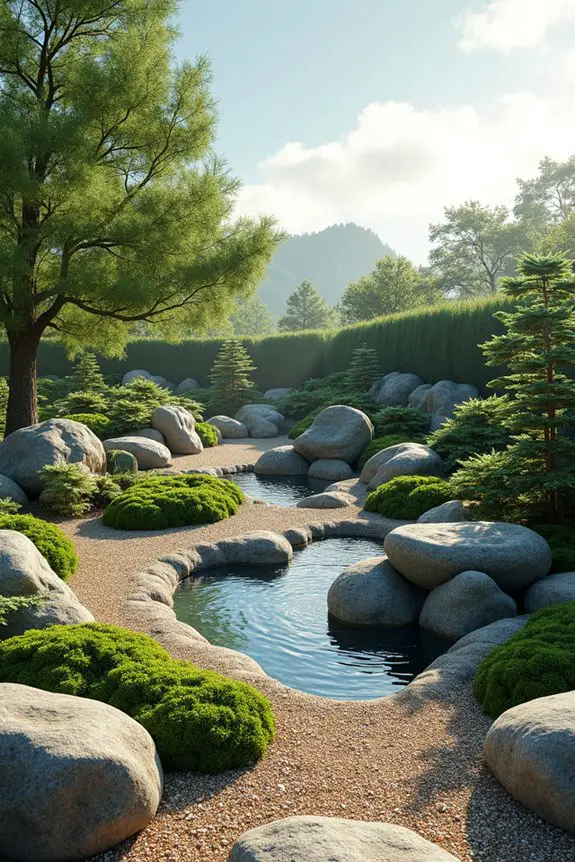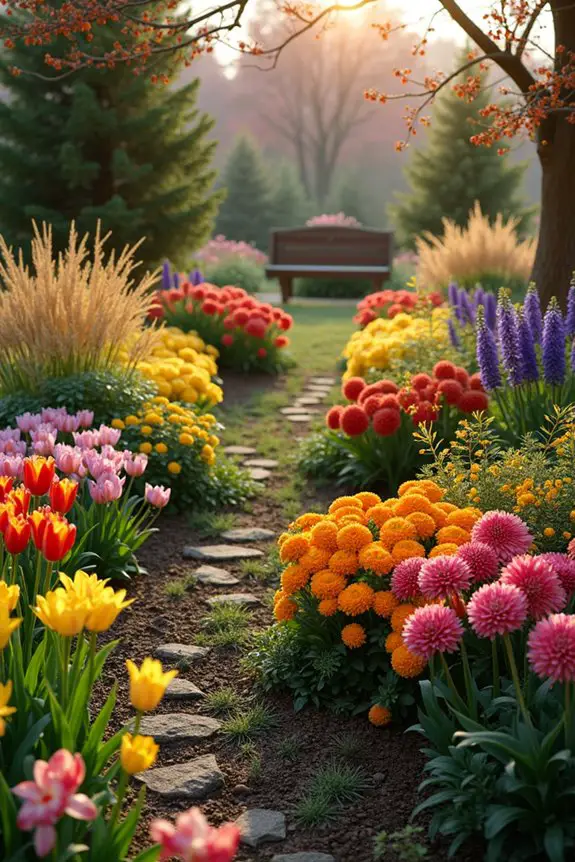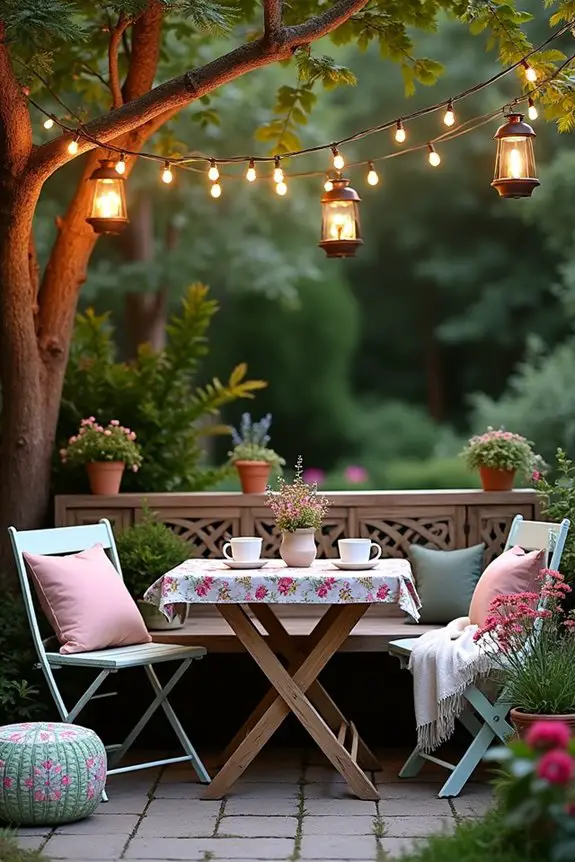Think of your garden as a blank canvas, just waiting for the right strokes to bring it to life. Ever wondered how a simple rockery can transform your outdoor space into a serene retreat? Picture unique stone formations mingling with vibrant plants, creating a harmonious escape right outside your door. You might even find yourself feeling more relaxed, and who wouldn’t want that? Stick around; there’s a treasure trove of ideas waiting for you.
Innovative Rockery Arrangements
When you think about innovative rockery arrangements, picture vibrant colors and textured stone layering that catches the eye.
Want to create an organic flow that feels like you’re wandering through nature? By mixing natural stone with carefully chosen plants, you can whip up a stunning garden that’s both unique and sustainable, making your space a true masterpiece.
1. Textured Stone Layering
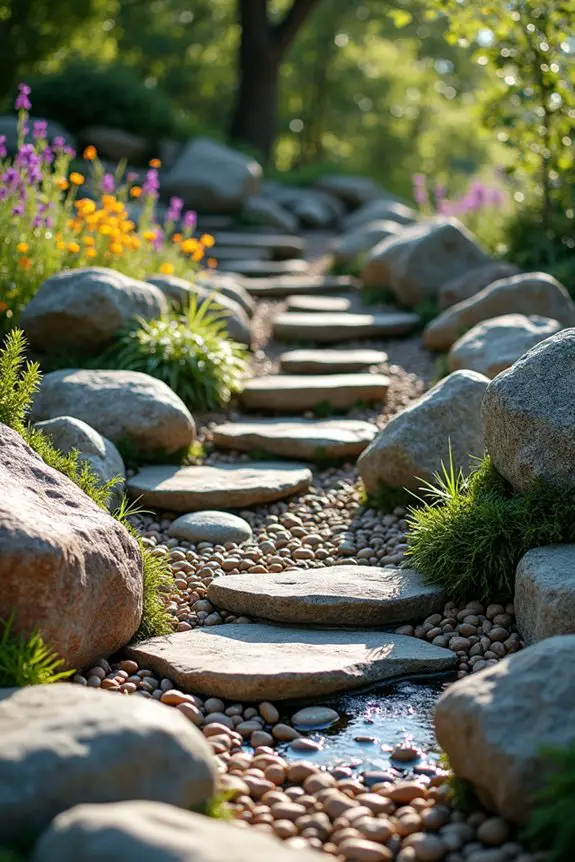
When it comes to rockery gardens, textured stone layering is like the secret ingredient that elevates the entire dish. Just like grandma’s special spice mix, it adds an essential depth and dimension that’s hard to imitate, creating a natural, organic feel that sparks joy in anyone who stumbles upon it. Plus, it’s functional; the layers not only look stunning, but they also help with drainage and erosion control.
Let’s explore the nitty-gritty of how to create your own eye-catching textured stone layers. Start with stones of various sizes—think pebbles, boulders, and even some medium-sized rocks for good measure. It’s a bit like cooking; don’t just toss everything into the pot. Arrange larger stones at the base, gradually working your way up with smaller stones. This will create a tiered appearance that’s not only visually appealing but also more stable.
Now, here’s where the fun starts. Try mixing textures! Smooth river rocks can partner beautifully with rugged, jagged stones. Picture it: the soft curves of the river rocks provide a mute contrast to the angular edges of the others, inviting a delightful play of light and shadow.
And hey, remember that one friend who can’t decide on a favorite dessert? That’s kind of how your rock arrangement can feel—there’s no right or wrong; it should be whatever flavors you enjoy.
Thinking about colors? That’s your next adventure. Mixing various shades, from earthy grays to warm reds, can turn your rockery into a canvas bursting with personality. Maybe toss in some moss or creeping plants in between the stones for a lush effect. Picture walking through your garden, feeling like you’re in a hidden wonderland instead of just your backyard.
And just a tip—don’t rush the process. It might look like a jumble at first, but give yourself time to step back and take it all in. You don’t want to be that person who over-seasoned their soup, right?
Sometimes stepping away helps to let the creativity simmer and bubble over into something truly magnificent. Additionally, using tools like a hori hori garden knife can enhance your planting experience by making it easier to dig and arrange your plants among your stones. Happy layering!
2. Colorful Plant Selections
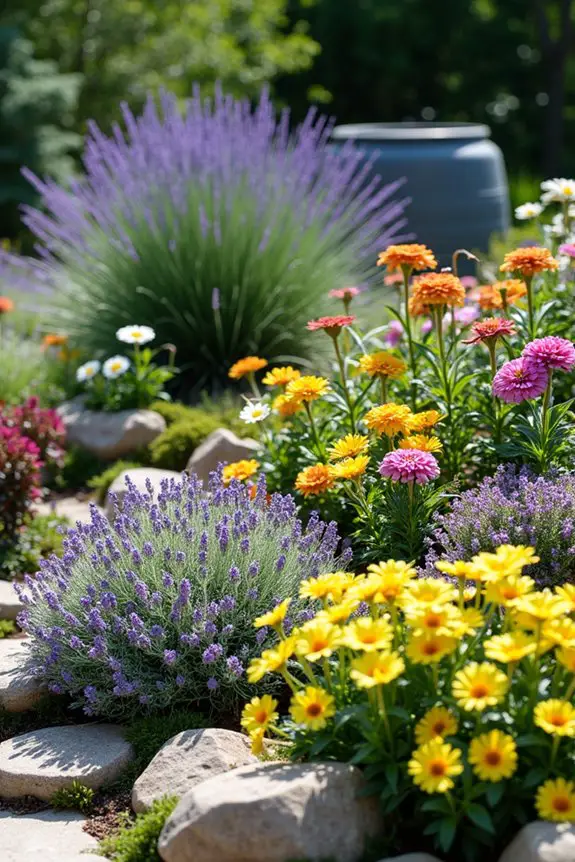
When it comes to creating a rockery garden that not only looks fab but also thrives, choosing colorful plant selections is key. Envision it like preparing a vibrant salad—it’s not just about the greens; it’s the bright tomatoes, crunchy cucumbers, and colorful bell peppers that make it pop. The right combination of plants can provide breathtaking bursts of color, enhance your stone arrangements, and create a lively atmosphere right in your backyard.
First things first, don’t be shy about mixing textures and colors. Imagine this: a soft lavender paired with spiky blue fescue grass and sunny yellow daisies. It’s that delightful combo of flavors that makes your mouth water, right? Consider plants that bloom at different times so your rockery remains dynamic throughout the seasons. You might start with cheerful pansies in spring, dance through the summer with bright zinnias, and cap it all off with fiery autumn chrysanthemums. That way, it’s like having a seasonal menu out there. Utilizing a simple rain barrel for garden can help you maintain moisture for these vibrant selections.
Next, think about varying heights and forms. Just like in a cooking pot, layering adds depth. Taller plants can stand proudly at the back, while trailing varieties can spill over the edges creating that effortless look. I mean, have you ever seen how a cascading plant can turn a boring rock into an aesthetic masterpiece? It’s like that magical moment when dessert meets your mouth, and everything comes together just right.
And here’s a hiccup I faced when I first started—be careful not to overcrowd your plants. It’s tempting to throw in every colorful flower you can find, just like when you try to add too many spices in a dish, and it turns out, well, not great. Give each plant room to breathe. This not only guarantees they’ve space to grow but also creates sightlines through your rockery, making it feel inviting and colorful without overwhelming the senses.
Finally, remember to sprinkle in some native plants. They’re like that wise old friend who knows just the right amount of seasoning to put in your soup. Not only are they well-suited to thrive in your local climate, but they also attract pollinators that can add even more life to your garden. Imagine buzzing bees and fluttering butterflies enjoying your well-planned feast of colors. Additionally, incorporating UV grow light sterilizers can help encourage healthy plant growth in indoor or shaded areas.
3. Natural Stone Integration
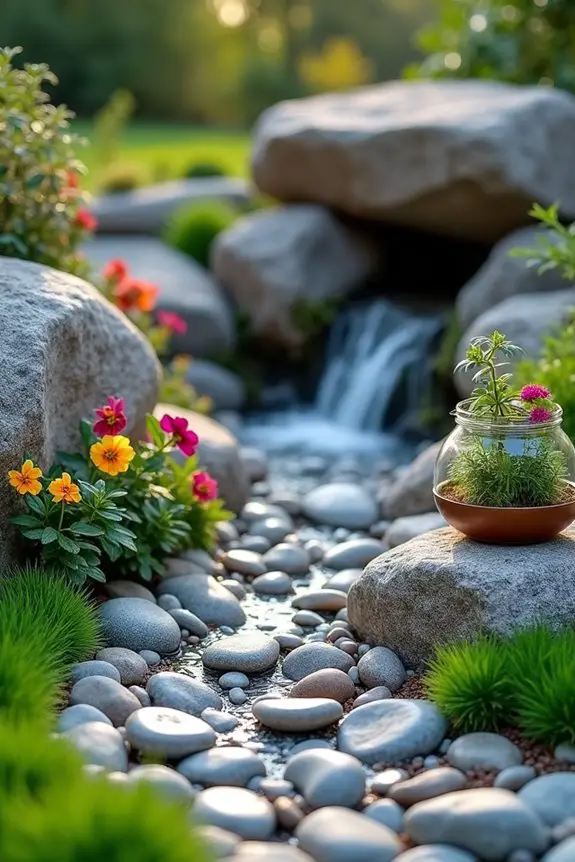
When you start thinking about integrating natural stones into your rockery garden, it’s like adding the perfect spice to a dish—it brings everything together and makes it pop. Not only do stones provide a solid base for your plants, but they also lend a rustic charm that can transport you straight to a peaceful mountain retreat right in your backyard. Additionally, incorporating a fogging misting kit can introduce a refreshing element to your garden, enhancing the overall atmosphere.
Picture this: strategically placing larger boulders mixed with smaller stones can create an inviting pathway for your eyes to wander. Imagine a gently cascading stream of round stones leading to a cluster of vibrant plants. That kind of arrangement draws you in, encouraging you to explore every nook and cranny of your garden. Plus, those natural stones can help retain moisture around your plants, working double-time to keep your greenery happy—almost like a good friend who always checks in on you.
When it comes to choosing the stones, don’t stick to just one type. Think about mixing colors and shapes, just like you’d when making a salad. Take some smooth, round river stones and pair them with jagged, rough-edged granite. The contrast not only looks stunning but also adds layers of interest. It’s like giving your rockery a diverse cast of characters, each bringing something special to the story.
Now, here’s a little tidbit from my own adventures: remember to securely place those stones. I once lost a boulder that rolled right into my neighbor’s garden while I was still figuring it all out. Lesson learned—safety first. Use sand or soil to stabilize your stones, ensuring they stay put, even when the weather gets wild. Including a closed terrarium jar in your rockery can also enhance its charm by providing a unique display of smaller plants.
Lastly, think about how the stones flow through your space. Ideally, they should guide the eye and complement the overall feel of your garden. If your garden feels like a chaotic pasta dish, it’s time to rethink your arrangement. Instead, aim for a harmonious blend where stones and plants dance together effortlessly, creating a beautiful melody of nature.
Trust me, once everything falls into place, you’ll feel like you’ve made a masterpiece—a deliciously colorful garden adorned with natural stone artistry.
4. Organic Flow Patterns
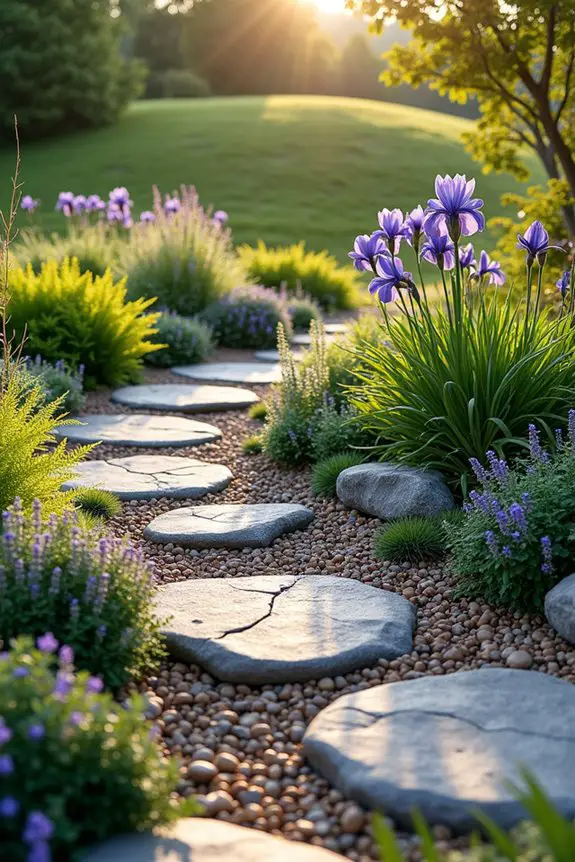
Creating organic flow patterns in your rockery garden is like orchestrating a beautiful symphony—each element harmonizes with the others, producing a pleasing visual experience. This approach does two important things: it enhances the functionality of your garden by effectively guiding visitors through it, and it adds a relaxed, natural vibe that makes you feel right at home, as if you’re strolling through an enchanted forest.
To start, think about how water flows in nature. Picture a river winding through rocks and plants, creating a sense of movement. Now, you can replicate that in your rockery. Use the larger stones as base points, then let smaller stones and plants meander in between, forming gentle curves and soft edges. This doesn’t just look nice; it invites you to explore, encouraging you to wander and discover new patches of beauty.
Here’s a little nugget of advice from my gardening trials: avoid those rigid, straight lines. They may work fine for a picket fence but can make your garden feel like a parking lot—definitely not what you want. Instead, let your arrangements mimic natural shapes, like soft hills or rolling waves. You’ll be surprised how just a little curve can transform the entire feel of your space.
Don’t be shy about mixing plant heights and textures. Pair the soft foliage of ferns with the sharp angles of sedums, and watch how they play off each other. Just like in cooking, where a little bit of crunch makes a salad stand out, contrasting textures add interest to your garden.
And don’t forget to test your arrangements before settling on a final layout. I’ve been known to get a bit overzealous, planting stones before fully committing to their placement. You can always reshuffle—there’s no shame in going back to the drawing board. After all, a little trial and error leads to better discoveries.
Finally, take a step back and observe the flow. Does it invite you in? Is it easy on the eyes? If not, tweak it until you find just the right balance. Once you’ve nailed those organic flow patterns, you’ll feel like you’ve crafted your own little paradise. Seriously, it’s the kind of place where you can sip lemonade and pretend you’re far away from the hustle and bustle.
5. Sustainable Material Selection
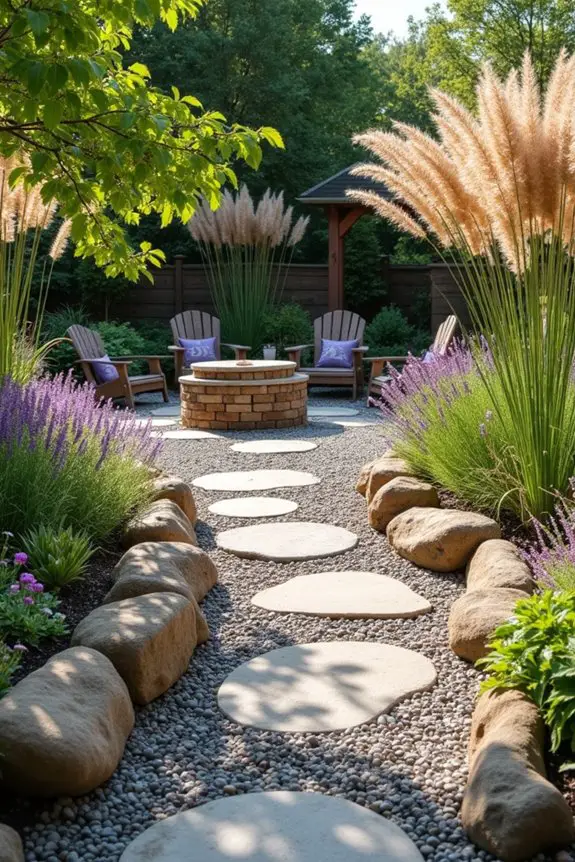
When it comes to creating a rockery garden, the materials you choose can be a game-changer. Sustainable material selection not only keeps our planet happy but also invites a unique charm that brings your rockery to life. Envision this: a patchwork of stones, wood, and recycled elements that work together like a well-balanced meal. You get the sturdy foundation of stone, the warmth of natural wood, and the eco-friendly touch of reclaimed materials. It’s functional AND stylish.
First off, consider using locally sourced stone. Not only does this support local businesses, but it also gives your garden a sense of place. It’s like cooking with fresh, local ingredients—you can taste the difference. Plus, you reduce the carbon footprint associated with transportation. Imagine arranging these stones in a way that creates cozy nooks or bold visuals. It’s all about showcasing what your area has to offer.
Next up, think about incorporating reclaimed wood. Old fence posts or pallets can serve as fantastic borders or shelves for your plants. They add character, a bit of rustic charm, and a backstory to your garden. Just make sure there’s no nasty paint or chemicals hanging around; no one wants to serve up a toxic salad. A little sanding goes a long way here.
Don’t overlook gravel, either. A good layer of gravel isn’t just pretty—it’s functional. It helps with drainage and keeps pesky weeds at bay. Plus, it comes in various colors and textures, allowing you to create patterns or pathways that guide visitors through your garden like inviting them to a fancy dinner party.
Think about laying down a pathway of smooth river stones leading to a hidden seating area; now that’s a surprise that’ll delight.
And hey, if you have old bricks lying around, don’t toss them! They can be repurposed into a stunning border or even used to build a small fire pit for cozy evening gatherings. It’s that classic “waste not, want not” mentality that should be on everyone’s gardening manifesto.
Lastly, remember—experiment. Don’t be afraid to move things around a bit. I’ve had my share of “oops” moments, realizing that the quirky stone I thought was perfect just didn’t gel with the rest. It’s all part of the process. Just like cooking, not every ingredient will mesh perfectly the first time.
But when you find that winning combination, you’ll feel like a rockstar in your own backyard. So, gear up with sustainable materials, and let’s craft a rockery garden that’s not only beautiful but conscious of nature’s needs as well.
6. Symbiotic Plant Groupings
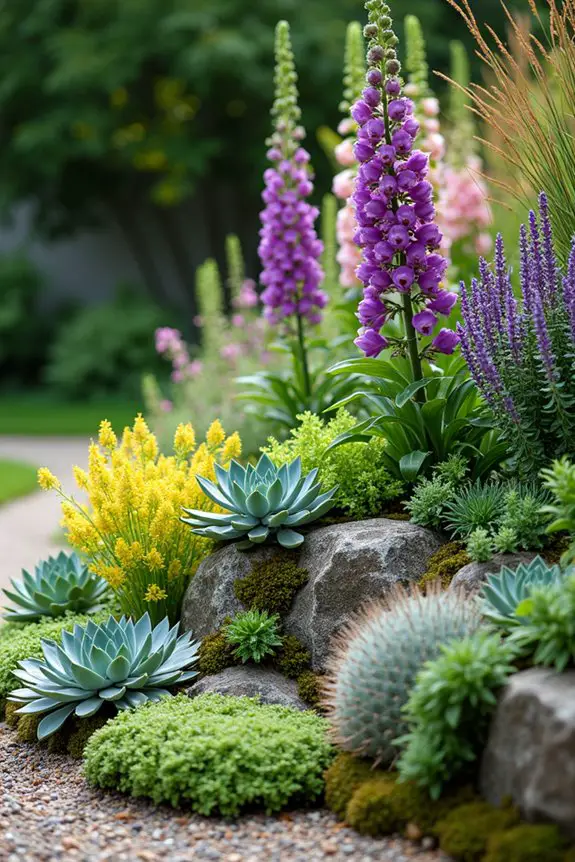
When it comes to rockery gardens, one of the most delightful things you can do is cluster plants in ways that they not only thrive but also create a visual feast. Enter the beauty of symbiotic plant groupings. This idea is like pairing the perfect wine with dinner—certain plants just get along famously, enhancing each other’s growth while crafting a breathtaking display of colors, textures, and scents.
Start by thinking about the sun and water needs of your plants. For instance, if you’re working with succulents, you want them sunny-side up, paired with drought-tolerant companions like lavender or thyme. These hardy plants can handle the heat and will flourish right beside those succulent stars. Envision the soft lavender bloom contrasting with the sleek greens of your succulents—eye-catching, right?
Next, let’s talk about height. Use taller plants like foxgloves or hollyhocks as your backdrop. They’ll stand tall and proud, like the stars in a rock opera, while allowing shorter plants like creeping thyme to spread out in front. This creates not just depth, but also a layered feel that draws visitors in. It’s like showcasing your version of a garden gallery.
And don’t forget about texture. Pair smooth-leaved plants with the spiky allure of ornamental grasses. It’s a delightful contrast that makes the eye dance. Imagine those vibrant tufts swaying gently in the wind, making your garden feel alive. I once paired some prickly pear cacti with fluffy decorative bulbs. It was an unexpected match, like chocolate and peanut butter—both unique, yet surprisingly compatible.
In practical terms, deep-rooted plants can help stabilize the soil, while shallow-rooted plants can fill in the gaps and create a dense canopy. This teamwork benefits both parties. Visualize a lovely blanket of moss under a lush fern, working hand in hand to fight off weeds and retain moisture—you’ve magically reduced your garden maintenance.
Here’s a quirky tip from my own adventures: sometimes what looks right on paper just doesn’t cut it in reality. I once envisioned a vivacious buddy system between a zesty ornamental pepper and a wide-leafed hosta, only to find out the hosta was more “meh” about sunshine. Note taken: be flexible.
Don’t shy away from rearranging until your garden resembles your flavorful vision. So go ahead, mix and match those plants. It’s an experiment, a trial, and hey, the best part? You can always learn from those botanical oopsies as you chase down your perfect rockery vibe!
7. Vertical Rockery Features
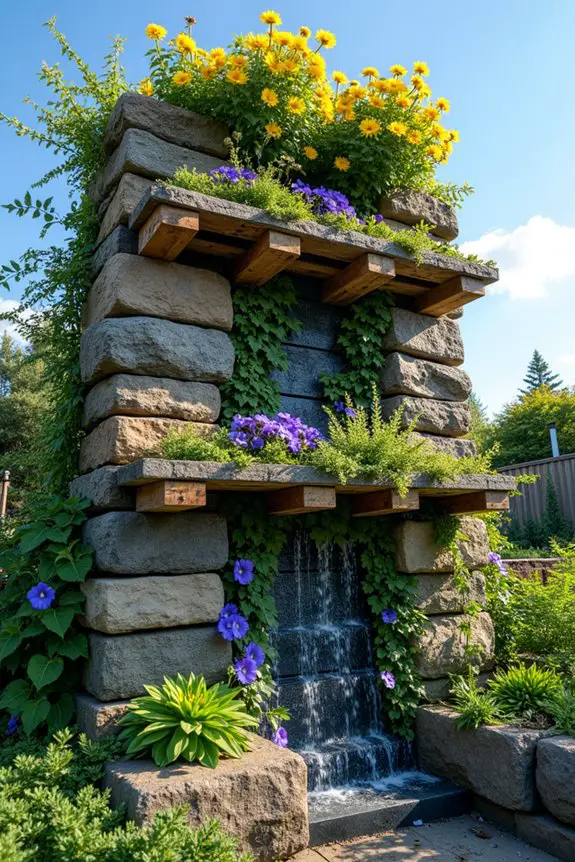
When thinking about creating a rockery garden, one of the most exciting elements is the incorporation of vertical features. These innovative rockery arrangements not only save space but also add a dynamic element to your outdoor space. Imagine turning a flat, boring section of your yard into a breathtaking vertical garden, bursting with blooms, textures, and visual interest.
First things first, let’s talk about structure. Using stones, bricks, or even wooden pallets, you can craft an eye-catching vertical garden that’s sturdy and stylish. Be sure to build it at a height that allows you to easily tend to your plants, because who wants to be in a yoga pose to water the top tier? I can’t count the times I’ve definitely tipped over trying to reach a high plant.
Tall arrangements usually lead to funny moments—just embrace the chaos.
Next, consider which plants are suited to your vertical oasis. Opt for climbing plants like clematis or sweet peas that can tangle up elegantly as they grow. If you’re looking for instant gratification, cascading plants like ivy or trailing lobelia can spill down the sides, creating a lovely waterfall effect. Picture it: vibrant greens tumbling over layers of stone—a scene straight out of a fairy tale garden.
Now, don’t forget about the importance of sunlight! Place drought-tolerant plants at the top where they can soak up those rays, while placing shade-lovers like ferns lower down. This way, no plant feels left out in the sun, and everyone gets their fair share of love.
It’s kind of like hosting a family picnic—everyone has their favorite spot to relax.
As you layer your plants, think about colors and blooms. Mixing and matching flowers with different colors can create a show-stopping effect, making your vertical garden a standout display. I’ve found that pairing purple petunias with bright yellow daisies creates a vibrant contrast that’s energizing. Just aim for balance—too many competing colors can make your garden feel chaotic, like when I tried to wear polka dots with stripes (yikes).
Finally, remember this is all about trial and error. If one plant isn’t thriving like you imagined, don’t hesitate to swap it out. Flexibility is key.
I once planted an adorably tiny clematis vine that turned out to be a bit too shy for the spotlight—it’s now happily placed where it can chill out and grow unbothered.
8. Water Feature Design
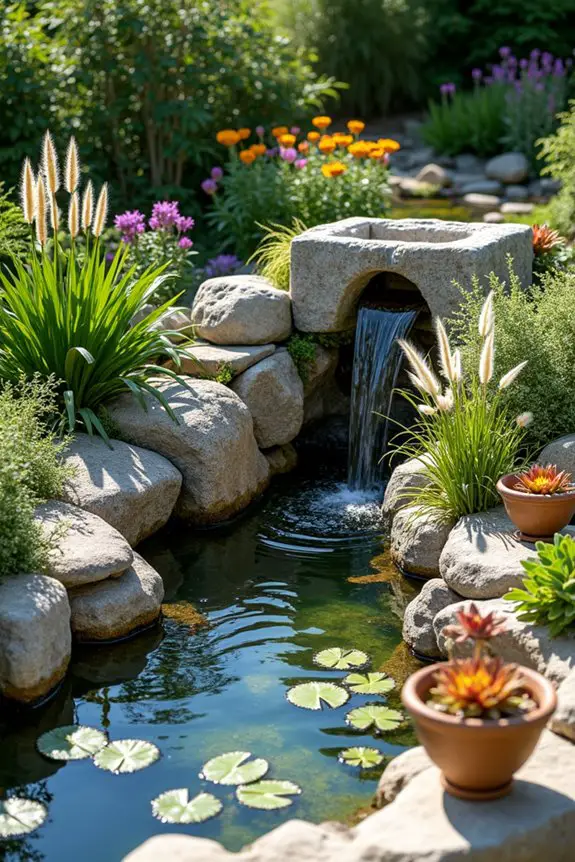
When it comes to designing a rockery garden, adding a water feature can elevate the whole vibe, creating a peaceful oasis right in your backyard. Picture the gentle sound of trickling water mingling with the rustle of leaves—a perfect combo for relaxation. Not only does a water feature serve as a stunning focal point, but it can also attract wildlife, bringing your garden to life with birds and butterflies.
Creating a water feature can be simpler than you might think. Start by choosing a spot that gets enough sunlight. A well-lit area helps keep the water fresh and inviting, while also providing the perfect backdrop for plants that love sunshine. You can go for a small pond, a bubbling fountain, or even a simple birdbath—whatever suits your style. Just make sure it’s something you can manage; I once thought to make a grand waterfall but ended up with a mini-reservoir that was begging for a snorkel.
Next, think about the shape and materials. Natural stones blend beautifully with rockery gardens, so why not use those? Round edges create a softer look, while jagged stones give an adventurous feel. I tried to make a sleek modern pond once, and let’s just say it looked more like a teenager’s attempt at a mud pie, to my neighbor’s delight.
Once you’ve settled on the shape, it’s time to add plants around your water feature. Choose moisture-loving companions like water lilies or marsh marigolds to frame your space. The contrast between vibrant foliage and the shimmering water creates stunning reflections; it’s like nature’s own mirror.
And don’t forget some low-maintenance elements. I used to think elaborate plants made for an impressive setup, but I’ve learned that sometimes simple is smarter, especially when you’re juggling a busy life (oh, the guilt of neglecting a high-maintenance plant).
Finally, remember to incorporate a pump if you’re going for a fountain or waterfall. It’s essential for keeping the water flowing and preventing stagnation—a must for plant health and keeping pesky mosquitoes away.
And if you find yourself overwhelmed, don’t worry. Just take it step by step. Like when I attempted baking a soufflé for the first time—lots of trial and error before I finally nailed it. You’ve got this. A water feature can truly be that magical touch to your rockery garden, transforming it into a little slice of nature’s serenity.
9. Contemporary Rock Formations
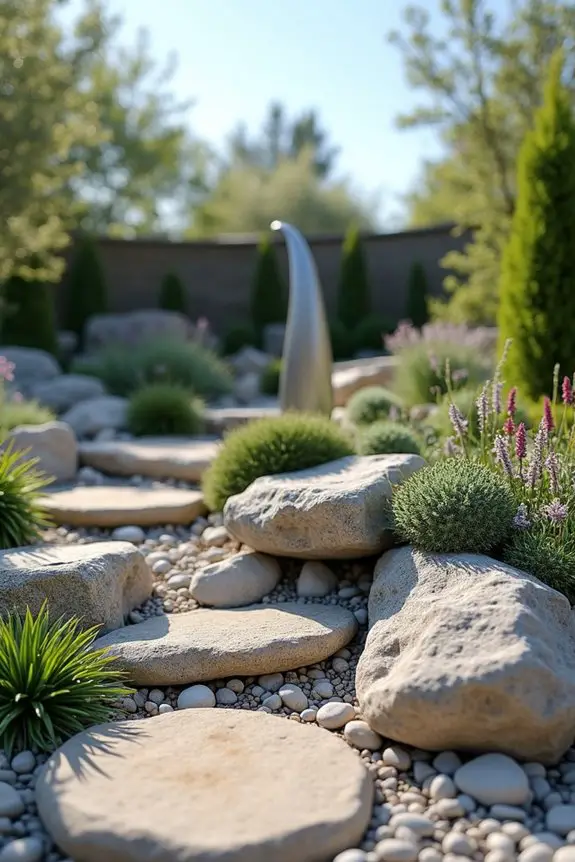
When it comes to adding flair to your rockery garden, contemporary rock formations can be a game-changer. These innovative arrangements not only jazz up the aesthetic but also provide a solid foundation for plants to thrive. Imagine sleek, modern lines juxtaposed with the ruggedness of natural stones. It’s like pairing a sharp blazer with comfy jeans—sophisticated yet welcoming.
Start by selecting a variety of rocks—think boulders, slabs, and pebbles. The mix creates depth and visual interest. I once gathered stones from a local riverbed, and trust me, that was a workout! But as I staggered home, out of breath and with a questionable sense of style, I realized I was crafting something beautiful. For that slightly contemporary vibe, go for larger rocks as a base and layer smaller stones on top, creating a cascading look that draws the eye. That’s the essence of modern rock formations—a playful take on nature’s chaos.
Next, think about how you arrange these rocks. You don’t have to be an artist; just try to group them in clusters of odd numbers. It creates a sense of natural randomness, which is surprisingly pleasing to the eye. I tried to evenly space my stones once, but it ended up looking like I was setting up a game of hopscotch instead. Remember, the goal is to evoke a relaxed yet stylish vibe.
Now, let’s talk plants. Create little pockets or ledges where you can tuck in some greenery. Succulents and alpine plants are great options. They love sunny spots and add pops of color against the stone backdrop. In my first attempt, I stuffed every cranny with flowers, but realized—less is more. A single succulent can stand out, like a whisper in a crowded room.
Finally, consider incorporating some modern art pieces or sculptures amidst the rocks. It’s like the cherry on top of your garden sundae. These features can bring a touch of whimsy and personality to your setting. Just avoid anything that screams “look at me!” too loudly, unless that’s the vibe you’re going for—my flamingo garden statue probably still thinks it’s in a Las Vegas show.
In the end, contemporary rock formations are about striking a balance—between natural beauty and chic design. So roll up your sleeves, get your hands dirty, and remember: it’s a journey. Much like my quest for the perfect chocolate chip cookie, there will be plenty of trials and maybe a few crumbs along the way. But oh, the rewards are worth it.
10. Zen-inspired Rockery Layouts
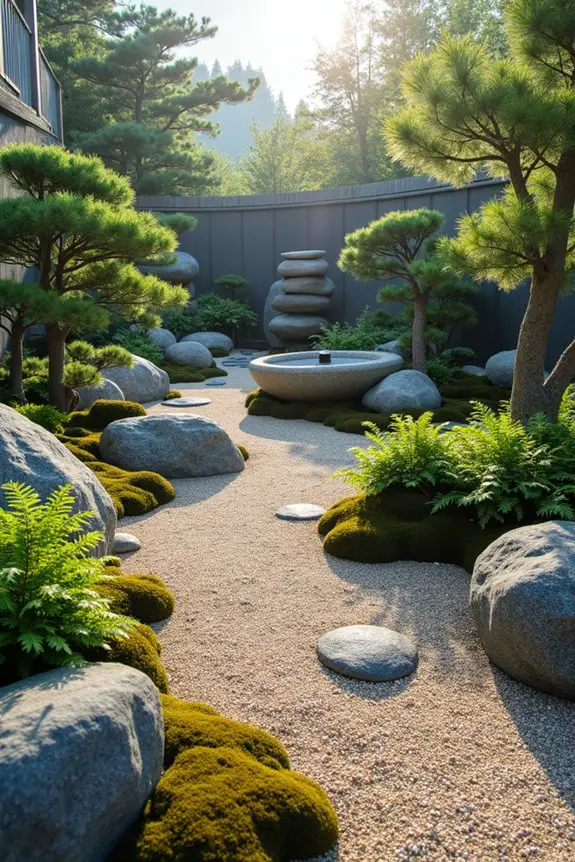
Creating a Zen-inspired rockery layout is like setting up a cozy nook for peace and reflection in your garden. This design works wonders for functionality—offering a serene escape—and for style—bringing a bit of tranquility into your outdoor space. Imagine stepping into a world where nature embraces simplicity, and you can almost hear the calming whispers of the wind.
To start, you’ll want to gather a mix of rocks and pebbles, focusing on smooth, rounded stones which promote an overall soothing vibe. I once made the mistake of choosing jagged rocks, and let’s just say my bare feet had a little too much excitement that day. Smooth stones not only look beautiful but are also nice to walk on, which is definitely a bonus for those blissful moments spent wandering through your own oasis.
Next, think about the layout. Instead of a chaotic hodgepodge of rocks, try arranging them in a gentle swirl or soft curves. This mimics the natural flow of water—like a tiny river running through your backyard. As I learned during my journey of arranging, a curved path invites you in, creating a sense of calm. So, don’t be afraid to get creative with shapes; your garden doesn’t have to look like it’s been assembled by a robot.
Now, add some plants that scream “Zen.” Things like moss, ferns, and dwarf conifers fit right in, adding layers of green without shouting for attention. I tried throwing in a flowering plant once, thinking it would bring a pop of color, but it just felt like I’d thrown a party crasher into a peaceful gathering. Instead, stick to subtle pops of greenery that complement the stone backdrop—like a whispering conversation.
Water features can be a great addition too. Even a small basin or a gentle fountain can bring that zen element to life. The sound of trickling water is like nature’s way of reminding you to take a deep breath. I attempted to DIY a little fountain once, and let’s say, my kitchen wasn’t ready for the splash zone. So, if you choose to incorporate water, maybe stick to something simpler than my grand aspirations.
Finally, remember to leave some open spaces. Too many rocks and plants can feel cramped, while open areas give you room to breathe and reflect. It’s like leaving some blank pages in a journal—inviting, right?
Setting up a Zen-inspired rockery layout is all about balance—finding that sweet spot between rocks, plants, and open space. So, gather your materials, let your creativity flow, and embrace the experience. Just like making a perfect cup of tea, it might take a few tries, but when you get it right, it can be wonderfully calming.
Plant Selection Strategies
Choosing the right plants for your rockery garden might feel a bit overwhelming—after all, there are so many options out there, and who wouldn’t want their garden to look like a scene from a fairytale?
Start by considering your climate; different plants thrive in different conditions, and you don’t want to fall for a delicate beauty that can’t handle your weather.
Look for perennial options like sedums or dwarf conifers—they’re practically foolproof.
Don’t forget about colors and textures; mixing stones and vibrant foliage creates that magical vibe.
You could even use rockery garden ideas like succulents for a low-maintenance twist.
And remember, it’s okay to experiment—if a plant flops, just swap it out for something new.

